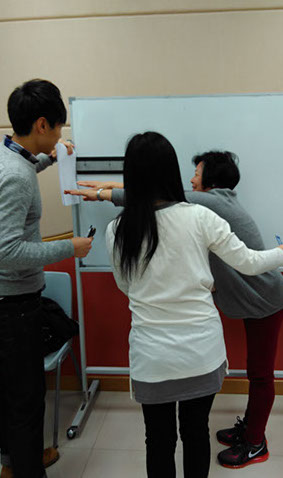An unusual experiential learning course run earlier this year saw students learning how to do balance assessments while running dance training workshops for the elderly to see if dancing could contribute to geriatric rehabilitation, specifically fall prevention.
Funded by HKU’s Gallant Ho Experiential Learning Centre and conducted in collaboration with the St Stephen’s Church Elderly Group, ‘Improving Balance and Preventing Falls in Elderly People through Dancing’ was run by students doing Rehabilitation Science as part of their Bachelor of Science in Exercise and Health.
Project Coordinator Dr Thomson Wong from the Division of Behavioural Science, School of Public Health, said the course was designed to benefit both the students and the elderly. “One of the objectives was to enhance students’ understanding of the application of rehabilitation science by giving them hands-on experiense,” he said. “If they don’t practise balance assessment in a real setting they may not understand properly the difficulties older people have.”
Before the main dance training sessions began the students attended workshops to learn two assessment techniques, the Berg Balance Scale and the Tinetti Balance and Gait Evaluation. They then underwent basic dance training, so they would be able to dance with elderly in the main workshops and give them encouragement.
-re-crop-u16289.jpg?crc=178781341)
![]() Students got hands-on experience in the field of geriatric rehabilitation and elderly fall prevention. They also had the chance to develop their problem-solving and critical-thinking skills, which in the long term will make them capable of developing similar health care programmes for the larger community.
Students got hands-on experience in the field of geriatric rehabilitation and elderly fall prevention. They also had the chance to develop their problem-solving and critical-thinking skills, which in the long term will make them capable of developing similar health care programmes for the larger community. ![]()
Dr Thomson Wong
Multiple dance styles
For the elderly participants, there were 12 dance training sessions – two hours each once a week – led by Jacky Mo, President of Hong Kong Western Dance Council. He taught them seven different dance styles – cha-cha, jive, rumba, salsa, waltz, tango and macarena – all modified to fit the age of the dancers.
“Jacky moderated the dance moves to match the older people’s abilities,” said Dr Wong. “The different dances require different skills – some such as the waltz are slow and dignified, other like the salsa are faster and require frequent turns. The macarena uses more upper body movements, while the cha-cha uses more lower body. The group also did warm-up exercises, stretches and cool-downs.”
Students performing balance assessment for one of the elderly participants.
-crop-u16301.jpg?crc=402368299)
Balancing Act
Balance impairment among the elderly often leads to serious issues such as falls, broken bones, and long convalescences in hospital. A new initiative hopes to improve the situation through dancing.
Dr Wong’s team running dance training workshops for the elderly.

All the students attended about four of these, dancing along with the participants and then conducting the balance assessments. The Berg Scale and Tinetti Evaluation involve marking participants on their ability to do tasks such as standing unsupported with eyes closed, picking an object up off the floor from a standing position, turning 360 degrees and standing on one leg.
Assessment after all training sessions enabled the students to see how their balance
improved – as well as their dance technique.
“Students got hands-on experience in the field of geriatric rehabilitation and elderly fall prevention,” said Dr Wong. “They also had the chance to develop their problem-solving and critical-thinking skills, which in the long term will make them capable of developing similar health care programmes for the larger community.
“The elderly participants gained too,” he added. “Not only did they have fun learning the dances and improving their technique but they also learned about their own balance abilities and limitations. It is hoped this may motivate them to continue to pursue recreational physical activities as a way to lessen their risk of falling.”
An unexpected bonus for both groups was the cross-generational camaraderie. “Both the elderly and the students got a lot out of meeting each other and working together,” said Dr Wong. “There was great interaction between the two age groups, and both sides came away from the programme feeling they would be happy if these workshops continued.”
Asked why the older participants were so keen, Dr Wong answered simply: “Fun. Sometimes exercise can be a chore, but dancing and moving to the music is enjoyable, it makes you feel good. Instead of the more traditional physiotherapy programmes, we thought physical recreation such as dance could be a good way to improve balance in older adults.”
The aim now is to get more funding to develop styles of dance training tailored specifically to improving balance in older people. For those who are reluctant to do exercise in the conventional sense, this could be a way forward.
The next step is to develop a programme of dance exercises designed specifically to help improve balance. “In tai chi, for example, there are 24 styles which target different parts of the body,” said
Dr Wong. “With new funding we would like to design different styles of dance to improve specific balance problems.”
Back


